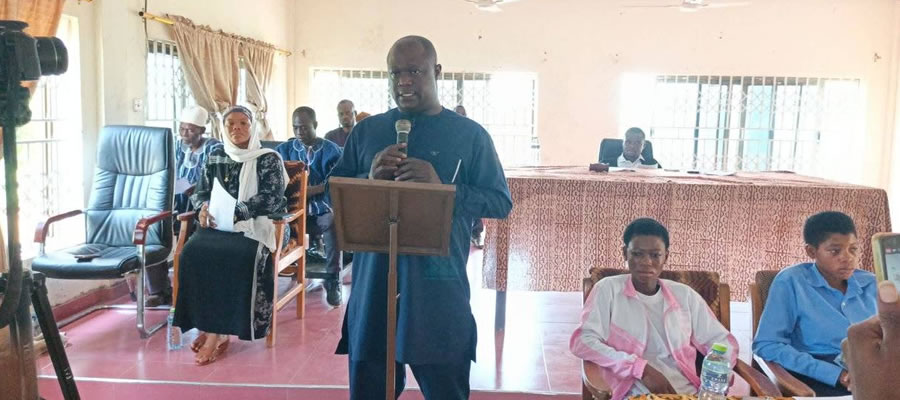

Health
Another important indicator for development is health. Poor health has effect on several other indicators like productivity, education and so on. Diseases like malaria are very hard to beat because of the existence of mosquitoes. However, it can be reduced if measures like awareness creating, good environmental practices and distribution of insecticide treated nets are intensified.
The District Health System
The District Health Management Team (DHMT) in collaboration with the Sub-district Health Management Teams (SDHMTs) implements and manages national and regional health policies in the District. To ensure participation and maximum use of resources the District Health Administration collaborates with relevant stakeholders including the District Assembly and Non-Governmental Organizations in the delivery of services.
The District health sector can be categorized into two sectors, public and private. The Ghana Health Service runs the public sector providing both curative and preventive care in the health centres and outreach stations. Community based disease surveillance volunteers have also been trained to assist in surveillance activities.
Drug outlets form a large proportion of the private sector including chemical sellers and unlimited number of drug peddlers who are mostly semi illiterate but very good salesmen. These drug peddlers can be categorized into three namely peddlers of herbal medicine, peddlers of biomedicine moving from community to community and the neo herbalists who sell both herbal and modern drugs.
Though Daffiama-Bussie-Issa District is relatively new district, it is not entirely lacking the basic health facilities that its citizens need for quality healthcare delivery. A survey of the District revealed that health centres and clinics are strategically located across the District to service the populace. Table 19 below illustrates the distribution of the health facilities in the District.
The distribution of existing facilities is evenly distributed across the District. There are Eighteen (18) health facilities in the district, that is, five (5) Health Centres, and thirteen (13) CHPS Compounds. The average distance to a health facility in the District has reduced from 16km to about 7km. This achievement still lags behind the National target of 5-kilometer maximum distance in accessing health services. This is indicative of poor physical accessibility to health services notwithstanding the increased outreach stations and static health facilities in the District.
Many people are also unable to access health services due to the prevailing poverty among the people. The existing health facilities are poorly equipped and staffed. Patient and staff accommodation is inadequate to meet current demands and communication between communities and health delivery outlets remains poor. There are also no Ambulance services in the District to facilitate movement of emergency referral cases to the Regional hospital for special services. These are all critical issues, which need immediate attention by the DA and the District Health Directorate.
The existing health facilities as indicated above are poorly equipped and staffed, however four(4) more are ear marked to be constructed at the following locations; Pulbaah, Chabaah, Banonyiri and Moyiri. Patient and staff accommodation is inadequate to meet current demands and communication between communities and health delivery outlets remains poor. There are also no Ambulance services in the District to facilitate movement of emergency referral cases to the regional hospital for special services. These are all critical issues, which needs immediate attention by the DA and the District Health Directorate. There are also 103 traditional birth attendances in the District.
Staffing
The staffing situation in the health sector is a major challenge in the delivery of quality and accessible health services. The number of nurses are inadequate with limited capacity though there have been interventions to improve their capacity through a number of training programmes. Nurse/patient ratio according to the health directorate currently stands at 1:380. As a measure of closing the gap, the District Assembly is to sponsor student nurses who intern to serve the District after completion of their course. A number of capacity building trainings are yet to be organized in collaboration with development partners to improve the capacity of nurses in the delivery of services. Table 20 below depicts the situation in the District.
Disease Prevalence
The current top three diseases in the district are Malaria, Acute Respiratory Infection (ARI) and Skin Diseases. This is a clear manifestation of poor environmental hygiene and sanitation as well as water related problems. Table 1.18 below highlights the incidence of the top ten (10) diseases in the Daffiama-Bussie-Issa District in 2017. Generally, there has been an improvement in health service delivery in the District. About 85% of the District population now seeks medical services at existing health facilities.
With the exception of malaria, there has been a considerable drop in the incidence of most of the top ten diseases in the District and patronage of health facilities have improved. These modest achievements have been as a result of increased outreach points, an improvement in logistics situation and staff training which is made possible through support of World Vision International and World Food Programme who are development partners in the education and health sectors of the District.
Nutrition
Through a multiple contact of children 0-59 months of age, very few were assessed as being severely malnourished (0.9%) and just a few (13.2%) being moderately malnourished. Many of these children were well nourished (85.7%) suggesting that Infant and Young Child Feeding (IYCF) have been well observed by mothers and surrogate care givers. Table 1.19 below shows the age distribution and the nutritional status of children within the various age categories:
However the Routine Child Welfare Clinic data on Growth Monitoring and Promotion suggests that most of this severely malnourish children came from Kojokperi sub-district and most moderately malnourish children located in Issa sub-district.
Immunization
The District has experienced tremendous coverage of its immunization programmes against the six childhood killer diseases, especially in the year 2013. Daily immunization at static points, outreach services and house-to-house strategies were used to achieve the increased coverage. Table 23 below highlights the antigen vaccination coverage of the district for 2013.
HIV/AIDS
The debilitating effects of HIV/AIDS on the socio economic development of any society cannot be overemphasized. In view of this the District Assembly, District Health Directorate and other development partners have embarked on a number of activities to sensitize the people on the effects and methods of HIV/AIDS infection. Despite the vigorous effort of stakeholders in HIV/AIDS prevention, there are still some prevalence of case; about 29 persons have been affected, among these all are male.
National Health Insurance Scheme
National Health Insurance Scheme is a governmental effort to make health care affordable and accessible to majority of people in the country. As such every district is required to have a District Mutual Health Insurance Scheme. In 2016, the District Assembly provided NHIS office in the District capital for NHIS operations that will prevent client from travelling to the then Nadowli District for NHIS services.
General Problems in the Health Sector
The general problems in the health sector include:
• Inadequate physical health infrastructure
• Inadequate spacious office accommodation
• Poor physical and economic access to health services
• Inadequate staff accommodation
• Intermittent shortage of immunization vaccines
• Lack of communication facilities in health centres
• High staff attrition
• Low immunization coverage
• Inadequate Critical staff especially midwives, TOs and PAs
• Inadequate logistics and transportation facilities
Date Created : 1/9/2019 7:34:40 AM











 facebook
facebook
 twitter
twitter
 Youtube
Youtube
 +233 593 831 280
+233 593 831 280 0800 430 430
0800 430 430 GPS: GE-231-4383
GPS: GE-231-4383 info@ghanadistricts.com
info@ghanadistricts.com Box GP1044, Accra, Ghana
Box GP1044, Accra, Ghana